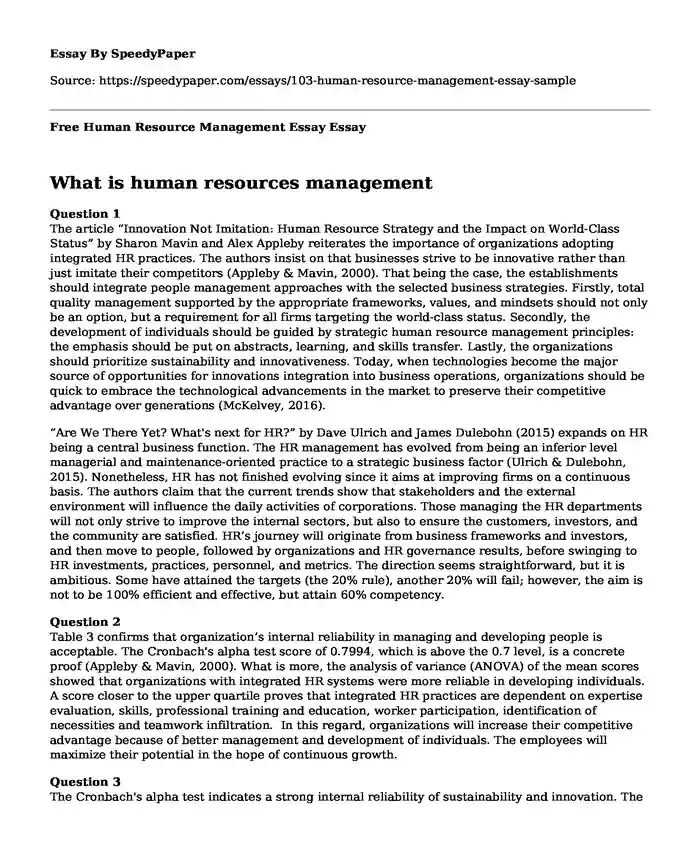
| Type of paper: | Essay |
| Categories: | Management Human resources Analysis |
| Pages: | 3 |
| Wordcount: | 640 words |
What is human resources management
Question 1
The article “Innovation Not Imitation: Human Resource Strategy and the Impact on World-Class Status” by Sharon Mavin and Alex Appleby reiterates the importance of organizations adopting integrated HR practices. The authors insist on that businesses strive to be innovative rather than just imitate their competitors (Appleby & Mavin, 2000). That being the case, the establishments should integrate people management approaches with the selected business strategies. Firstly, total quality management supported by the appropriate frameworks, values, and mindsets should not only be an option, but a requirement for all firms targeting the world-class status. Secondly, the development of individuals should be guided by strategic human resource management principles: the emphasis should be put on abstracts, learning, and skills transfer. Lastly, the organizations should prioritize sustainability and innovativeness. Today, when technologies become the major source of opportunities for innovations integration into business operations, organizations should be quick to embrace the technological advancements in the market to preserve their competitive advantage over generations (McKelvey, 2016).
“Are We There Yet? What's next for HR?” by Dave Ulrich and James Dulebohn (2015) expands on HR being a central business function. The HR management has evolved from being an inferior level managerial and maintenance-oriented practice to a strategic business factor (Ulrich & Dulebohn, 2015). Nonetheless, HR has not finished evolving since it aims at improving firms on a continuous basis. The authors claim that the current trends show that stakeholders and the external environment will influence the daily activities of corporations. Those managing the HR departments will not only strive to improve the internal sectors, but also to ensure the customers, investors, and the community are satisfied. HR’s journey will originate from business frameworks and investors, and then move to people, followed by organizations and HR governance results, before swinging to HR investments, practices, personnel, and metrics. The direction seems straightforward, but it is ambitious. Some have attained the targets (the 20% rule), another 20% will fail; however, the aim is not to be 100% efficient and effective, but attain 60% competency.
Question 2
Table 3 confirms that organization’s internal reliability in managing and developing people is acceptable. The Cronbach's alpha test score of 0.7994, which is above the 0.7 level, is a concrete proof (Appleby & Mavin, 2000). What is more, the analysis of variance (ANOVA) of the mean scores showed that organizations with integrated HR systems were more reliable in developing individuals. A score closer to the upper quartile proves that integrated HR practices are dependent on expertise evaluation, skills, professional training and education, worker participation, identification of necessities and teamwork infiltration. In this regard, organizations will increase their competitive advantage because of better management and development of individuals. The employees will maximize their potential in the hope of continuous growth.
Question 3
The Cronbach's alpha test indicates a strong internal reliability of sustainability and innovation. The HR strategy employed in each firm significantly affects its ability to maintain certain standards and foster creativity. Those with integrated HR systems post higher scores than those with unintegrated structures (Appleby & Mavin, 2000). As a matter of fact, an ANOVA mean score close to the upper quartile indicates that integrated firms have higher customer satisfaction rates, they are prone to inventions and the development of new concepts as well as services, and they can monitor their progress. In other words, creativity boosts the establishments going concern, while ensuring that they remain relevant over decades.
References
Appleby, A., & Mavin, S. (2000). Innovation not imitation: Human resource strategy and the impact on world-class status. Total Quality Management, 11(4-6), 554-561.
McKelvey, M. (2016). Firms navigating through innovation spaces: a conceptualization of how firms search and perceive technological, market and productive opportunities globally. Journal of Evolutionary Economics, 26(4), 785-802.
Ulrich, D., & Dulebohn, J. H. (2015). Are we there yet? What's next for HR? Human Resource Management Review, 25(2), 188-204.
Cite this page
Free Human Resource Management Essay. (2018, Mar 17). Retrieved from https://speedypaper.net/essays/103-human-resource-management-essay-sample
Request Removal
If you are the original author of this essay and no longer wish to have it published on the SpeedyPaper website, please click below to request its removal:
- Paper Example: Investigating Quality of Service Issues - Conclusions
- Writing Essay Example
- Law Essay Sample on Guilty Plea in Criminal Law
- Description of Salmonella and Reasons for Contamination, Essay Sample
- Japan Essay Example
- Application of Aristotle's Theory to Hernado Ocampo's "Rice and Bullets" - Essay Sample
- How the Federal Reserve Oversteps Biblical Principles - Essay Sample
Popular categories




